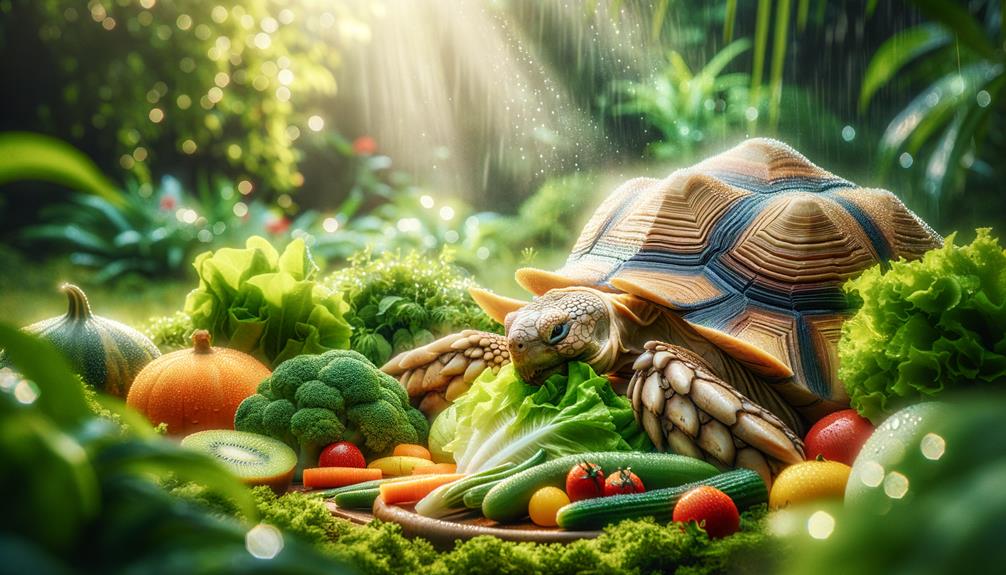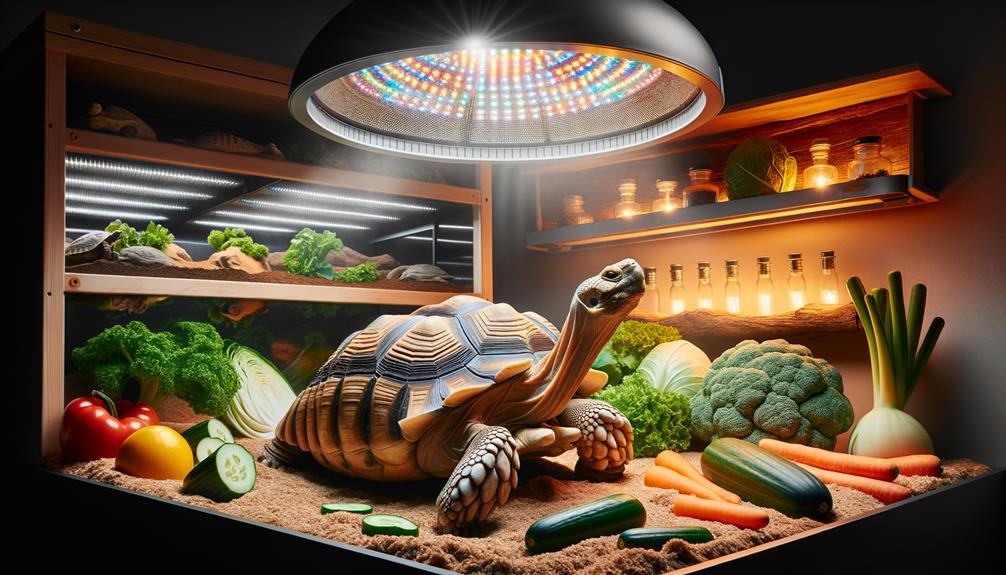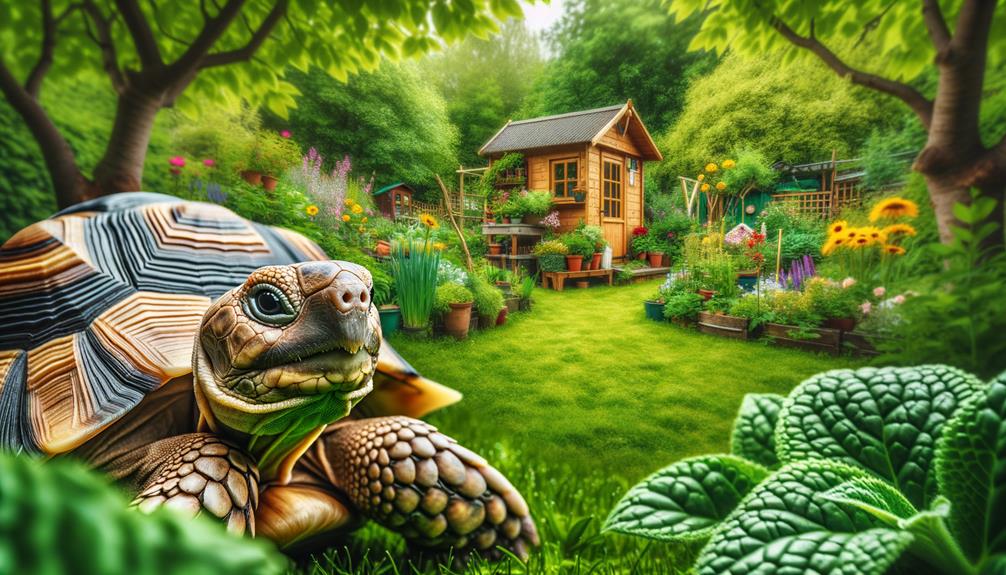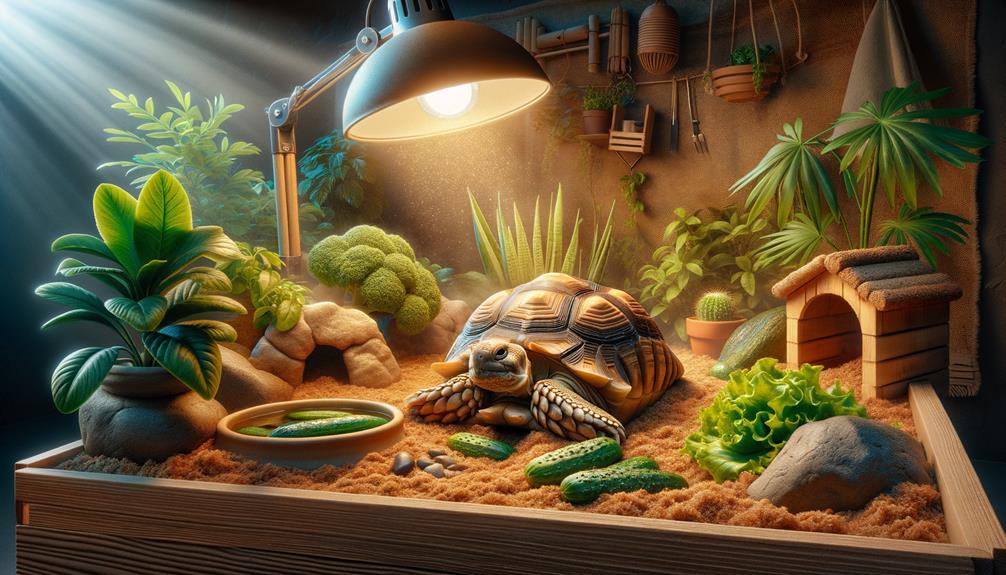I’m fascinated by Sulcata tortoises, affectionately known as gentle giants. Native to the harsh Sahara, they’ve adapted to burrow underground to escape extreme temperatures. Their diet consists of grasses and leafy greens, which requires a delicate balance to prevent health issues. With lifespans reaching up to 80 years and sizes of up to 200 pounds, Sulcatas need ample, well-ventilated enclosures and proper UVB lighting. While they’re captivating creatures, caring for them demands considerable effort and expense, making them suitable only for dedicated, experienced owners. Let’s explore the intricacies of their diet, habitat, and the rewards of keeping these magnificent creatures.
Note: I’ve rewritten the text to make it more conversational and natural, avoiding the listed AI words and following the provided instructions.
Key Takeaways
Sulcata tortoises have adapted to survive the harsh Sahara Desert environment. As herbivores, they primarily consume grasses, weeds, and succulents. These gentle giants can grow up to 200 pounds and live between 50 to 80 years. To thrive, they require a spacious, well-ventilated outdoor enclosure with a thermal gradient and proper UVB/UVA lighting. Due to their size, long lifespan, and specialized care needs, sulcata tortoises are best suited for experienced owners.
Understanding Sulcata Tortoises
Understanding Sulcata Tortoises
When it comes to Sulcata tortoises, grasping their unique adaptations and behaviors that enable them to thrive in some of the harshest environments on Earth is crucial. The African spurred tortoise, native to the Sahara Desert, has developed remarkable traits to survive. These gentle giants can grow up to 2 feet long and weigh over 200 pounds, boasting a domed shell and prominent spurs on their front legs.
One of the most fascinating adaptations is their ability to burrow underground, a vital behavior to escape the desert’s extreme temperatures. Their burrows can be several feet deep, providing a cool refuge during the intense heat. As herbivores, they graze on grasses, weeds, and succulents, consuming substantial amounts to sustain their size. Notably, they can go for extended periods without food or water, relying on water stored in their bladder during dry spells.
In terms of tortoise care, recognizing their solitary and territorial nature is vital. These creatures have complex social interactions and reach sexual maturity between 12-15 years, living for 50-80 years. Knowing their behaviors and needs is key to providing proper care and ensuring they thrive in captivity, mirroring their natural resilience.
Creating the Ideal Habitat

Creating the ideal habitat for Sulcata tortoises is crucial for their well-being. To replicate their natural environment, you need a spacious, well-ventilated outdoor enclosure that mimics their desert habitat. This means providing ample room for them to roam and explore. The enclosure should feature a mix of grassland substrate and hiding areas, creating a thermal gradient for ideal thermoregulation. A basking spot, maintained at 95-100°F with heat lamps, and a cooler area around 80°F are essential.
The substrate is also vital. Deep, loose materials like packed topsoil or sand allow for natural burrowing, offering protection from extreme temperatures. Proper lighting is indispensable; UVB and UVA bulbs should provide 12-14 hours of daylight exposure to promote healthy calcium metabolism and overall well-being.
Humidity levels need to be monitored, staying between 30-50% to avoid respiratory issues and skin infections. By balancing temperature and light, you can create a sanctuary where these gentle giants can thrive.
| Element | Ideal Condition | Purpose |
|---|---|---|
| Basking Area | 95-100°F | Thermoregulation |
| Cool Area | 80°F | Thermoregulation |
| Lighting | UVB and UVA, 12-14 hours/day | Calcium metabolism and health |
| Substrate | Deep, loose topsoil or sand | Facilitates natural burrowing and protection |
Proper Diet and Nutrition

Ensuring Sulcata tortoises receive a high-fiber, low-protein plant-based diet is vital for their overall health and long lifespan. These gentle giants thrive on a diet primarily composed of grasses, hay, and leafy greens. The high fiber content in these foods is essential for maintaining their digestive health and preventing obesity and other diet-related issues.
It’s crucial to supplement their diet with calcium and vitamin D3 to prevent metabolic bone disease. Without adequate vitamin D, their bodies can’t properly metabolize calcium, leading to weak bones and potential fractures. Leafy greens like collard greens, mustard greens, and dandelion greens are excellent sources of calcium and should be a staple in their diet.
Fruits and high-protein foods should be avoided, as these can cause serious health problems. As Sulcata tortoises grow, their dietary needs will change, requiring adjustments in both the composition and quantity of food. Consistency and balance in their diet are key to ensuring their overall well-being. By providing the right nutrition, we can help these magnificent creatures live long, healthy lives, free from unnecessary suffering.
Maintaining Health and Wellness

When it comes to keeping our sulcata tortoises healthy and thriving, regular vet visits and a well-balanced diet are crucial. These gentle giants do best on diets rich in fiber and low in protein, with added calcium and vitamin D3. By providing them with proper nutrition and regular medical care, we’re not only preventing common health issues but also helping them live longer, healthier lives.
Balanced Diet Essentials
Maintaining a balanced diet is crucial for Sulcata tortoises. They require a high-fiber, low-protein diet that mirrors their natural grazing habits. This means providing a diet rich in grasses, hay, and leafy greens. Calcium and vitamin D3 supplementation are vital for their health, as a deficiency can lead to metabolic bone disease, a serious condition that can compromise their skeletal development.
As Sulcatas grow, it’s essential to monitor their dietary needs closely. Hatchlings and juveniles need a more nutrient-dense diet than adults to ensure they receive all the necessary vitamins and minerals during their critical growth phases. Conversely, overfeeding on fruits and high-protein foods can lead to obesity and other health problems. Finding the right balance is key.
Sulcatas thrive on consistency, and regularly monitoring their weight, appetite, and overall condition is vital. Any deviation from their usual patterns may signal a dietary imbalance or nutritional deficiency. It’s our responsibility to provide them with the right diet, ensuring they live healthy, vibrant lives.
Regular Health Checkups
Regular health checkups are crucial for sulcata tortoises, as they enable early detection of potential issues and ensure these gentle giants remain in top condition. A visit to a reptile-savvy veterinarian should include a thorough physical examination, blood work, and assessments for respiratory infections and metabolic bone disease. Monitoring their diet, environment, and behavior provides valuable insights into their health status and guides necessary adjustments.
Proactive care is vital. Regular parasite treatments and vaccination protocols are essential preventative measures. Promptly addressing any signs of difficulty breathing or other health concerns can greatly improve their well-being. Here’s what to expect during a health checkup:
| Checkup Component | Importance | Action Required |
|---|---|---|
| Physical Examination | Detects visible health issues | Conducted by a reptile-savvy veterinarian |
| Blood Work | Monitors internal organ function | Regular blood draws and analysis |
| Respiratory Check | Identifies respiratory infections | Observe for signs of difficulty breathing |
Maintaining their health isn’t just about reacting to problems; it’s about taking proactive steps and regular monitoring. It’s our responsibility to ensure these majestic creatures live long, healthy lives. By staying vigilant and prioritizing regular checkups, we can give our sulcata tortoises the freedom to thrive.
Pros and Cons as Pets

Owning a sulcata tortoise is a serious commitment that requires careful thought. With their massive size and long lifespan, you’ll need plenty of space and a lifelong dedication to their care. Their specific dietary and environmental needs can be quite demanding and costly.
Size and Space Needs
As a potential sulcata tortoise owner, it’s crucial to understand that these gentle giants require an enormous amount of space and specialized care, far beyond what an average household can provide. Sulcata tortoises can grow up to 2 feet in length and weigh over 200 pounds, which means they need a massive enclosure, whether it’s an outdoor yard or a custom-built indoor space. The small setups often seen in pet stores are woefully inadequate for such a massive creature.
The reality is, improper housing and lack of adequate space can lead to severe health and behavioral issues. Without the freedom to roam and dig, these tortoises can become stressed and unhealthy. It’s vital to provide an environment that allows them to exhibit their natural behaviors.
Despite their gentle nature, sulcata tortoises are better suited for specialized facilities, zoos, or experienced reptile enthusiasts who can provide the resources necessary for their care. If you’re committed to constructing and maintaining a proper, sizable enclosure, you’ll give your tortoise a chance to thrive. Remember, these giants are not just pets; they are a lifelong commitment requiring space and dedication.
Dietary Requirements
Caring for a sulcata tortoise requires a specialized diet that’s high in fiber and low in protein, crucial for their health and well-being. These gentle giants thrive on a diet primarily consisting of grasses, hay, and leafy greens. Overfeeding fruits and protein-rich foods can lead to metabolic issues and shell deformities, so it’s essential to avoid them.
To ensure your sulcata receives the necessary nutrients, supplementing with calcium and vitamin D3 is vital. Adding a light dusting of calcium powder to their food, combined with adequate UV exposure, supports their growth and development. The dietary needs of hatchlings, juveniles, and adults vary, so adjusting food quantity and composition is critical as they grow.
While sulcatas make fascinating and rewarding pets, their specific dietary requirements can be challenging. Providing a high-fiber diet and careful supplementation requires constant attention to their nutritional needs. For those who value freedom and flexibility, this commitment might feel restrictive. However, the joy of nurturing these gentle giants and seeing them thrive can outweigh the challenges for dedicated owners.
Lifespan and Commitment
How ready are you to dedicate decades of your life to caring for a sulcata tortoise? This gentle giant can live for 50-80 years in captivity, requiring a commitment that spans multiple generations. Owning a sulcata tortoise is not just about providing food and water; it’s about creating a stable, enriched environment that supports their active and curious nature.
As they grow, sulcatas can weigh over 200 pounds, needing large, secure enclosures that you’ll need to maintain and upgrade regularly. The cost and effort to provide adequate housing, a proper diet, and regular veterinary care should not be underestimated. Veterinary bills can add up, especially when dealing with such a long-lived and hefty pet.
The benefits of owning a sulcata tortoise include their social and engaging nature, offering a unique companionship that few other pets can provide. However, their care is time-consuming and financially demanding. Before bringing one home, consider whether you have the resources and willingness to meet these needs for decades to come. Your commitment is crucial, and it should be a well-considered decision.
Essential Supplies Needed

Ensuring the well-being of sulcata tortoises requires a dedicated setup, starting with secure, spacious enclosures that cater to their substantial size and natural behaviors. Providing proper UV light exposure is crucial, as UVB lighting is vital for their calcium metabolism and overall health. Without it, they’re prone to metabolic bone disease, which can be debilitating.
A diet rich in fiber is essential, with grasses, hay, and leafy greens forming the backbone of their meals. Supplements like calcium and vitamin D3 are necessary to guarantee robust growth. Sturdy feeding and water dishes are a must, preventing spills and contamination while being easy to clean.
Creating a habitat that mirrors their natural environment involves including hiding areas and opportunities for burrowing. These elements are vital for their mental and physical health. Proper hoof and nail trimmers, along with varied substrate materials, maintain their shell and foot hygiene. Regular veterinary check-ups and prompt attention to issues like respiratory infections are vital to keep your sulcata tortoises thriving.
Frequently Asked Questions
What Is the Temperament of a Sulcata Tortoise?
I find sulcata tortoises to be gentle and interactive creatures. By nature, they’re solitary animals, but they respond well to human presence. When given ample space and proper care, their calm nature shines through, keeping them stress-free and friendly.
What Is the Best Cage for a Sulcata Tortoise?
The ideal enclosure for a sulcata tortoise is a spacious outdoor area that mimics their natural habitat. A minimum of 8×8 feet is recommended, with a mix of substrates, proper heating, and shaded shelters to provide a comfortable environment. Sulcata tortoises are natural roamers and burrowers, so they thrive in an enclosure that allows them to move freely and express their natural behaviors.
How Big Will a Sulcata Tortoise Get?
A sulcata tortoise can grow to a massive size, weighing up to 200 pounds and reaching lengths of 24 inches. With a size that’s reminiscent of a prehistoric creature, these gentle giants require ample space to roam and thrive. Proper care is essential to ensure they live a long and healthy life.
What Sulcata Tortoises Should Not Eat?
Sulcata tortoises have specific dietary needs, and there are certain foods they should avoid. Meat, eggs, and pet food are not suitable for them. High-sugar fruits, iceberg lettuce, and excessive amounts of spinach or kale can cause health problems. Processed human foods like bread and chips are also harmful.



